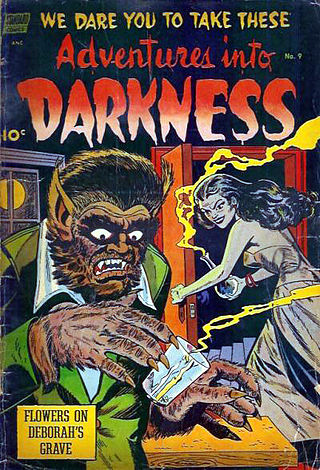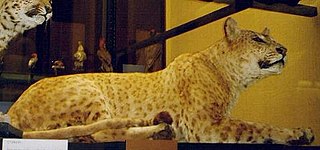
The Malleus Maleficarum, usually translated as the Hammer of Witches, is the best known treatise purporting to be about witchcraft. It was written by the German Catholic clergyman Heinrich Kramer and first published in the German city of Speyer in 1486. Some describe it as the compendium of literature in demonology of the 15th century. Kramer blamed women for his own lust, and presented his views as the Church's position. The book was condemned by top theologians of the Inquisition at the Faculty of Cologne for recommending unethical and illegal procedures, and for being inconsistent with Catholic doctrines of demonology.

In folklore, a werewolf, or occasionally lycanthrope is an individual who can shape-shift into a wolf, either purposely or after being placed under a curse or affliction, with the transformations occurring on the night of a full moon. Early sources for belief in this ability or affliction, called lycanthropy, are Petronius (27–66) and Gervase of Tilbury (1150–1228).

In Mesoamerican folk religion, a nagual or nahual is a human being who has the power to shapeshift into their tonal animal counterpart. Nagualism is tied to the belief one can access power and spiritual insight by connecting with the tonal animal within.

In mythology, folklore and speculative fiction, shapeshifting is the ability to physically transform oneself through unnatural means. The idea of shapeshifting is in the oldest forms of totemism and shamanism, as well as the oldest existent literature and epic poems such as the Epic of Gilgamesh and the Iliad. The concept remains a common literary device in modern fantasy, children's literature and popular culture.

Werewolf fiction denotes the portrayal of werewolves and other shapeshifting therianthropes, in the media of literature, drama, film, games and music. Werewolf literature includes folklore, legend, saga, fairy tales, Gothic and horror fiction, fantasy fiction and poetry. Such stories may be supernatural, symbolic or allegorical. A classic cinematic example of the theme is The Wolf Man (1941) which in later films joins with the Frankenstein Monster and Count Dracula as one of the three famous icons of modern day horror. However, werewolf fiction is an exceptionally diverse genre, with ancient folkloric roots and manifold modern re-interpretations.
Clinical lycanthropy is a rare psychiatric syndrome that involves a delusion that the affected person can transform into, has transformed into, or is, a non-human animal. Its name is associated with the mythical condition of lycanthropy, a supernatural affliction in which humans are said to physically shapeshift into wolves.

A Congolese spotted lion, also known by the portmanteau lijagulep, is the hybrid of a male lion and female jaguar-leopard. Several lijaguleps have been bred, but only one appears to have been exhibited as a Congolese spotted lion. It was most likely given that name by a showman because the public were more interested in exotic captured animals than in captive-bred hybrids.
A Panthera hybrid is a crossbreed between individuals of any of the five species of the genus Panthera: the tiger, lion, jaguar, leopard, and snow leopard. Most hybrids would not be perpetuated in the wild as the territories of the parental species do not overlap and the males are usually infertile. Mitochondrial genome research revealed that wild hybrids were also present in ancient times. The mitochondrial genomes of the snow leopard and the lion were more similar to each other than to other Panthera species, indicating that at some point in their history, the female progeny of male ancestors of modern snow leopards and female ancestors of modern lions interbred with male ancestors of modern snow leopards.

Werehyena is a neologism coined in analogy to werewolf for therianthropy involving hyenas. It is common in the folklore of the Arabian Peninsula, the Levant, North Africa, the Horn of Africa, and the Near East as well as some adjacent territories. Unlike werewolves and other therianthropes, which are usually portrayed as being originally human, some werehyena lore tells of how they can also be hyenas disguised as humans.
Therianthropy is the mythological ability or affliction of individuals to metamorphose into animals or hybrids by means of shapeshifting. It is possible that cave drawings found at Cave of the Trois-Frères, in France, depict ancient beliefs in the concept.
Were and wer are archaic terms for adult male humans and were often used for alliteration with wife as "were and wife" in Germanic-speaking cultures.
Cynanthropy is, in psychiatry, the pathological delusion of real persons that they are dogs and in anthropology and folklore, the supposed magical practice of shape-shifting alternately between dog and human form, or the possession of combined canine and human anatomical features, a form of therianthropy.

Parc des Félins is a zoological park in France dedicated to the breeding and conservation of wild members of the cat family. It is located in the commune of Lumigny-Nesles-Ormeaux in Seine-et-Marne, about 53.6 km (33.3 mi) southeast of Paris.

Panthera Corporation, or Panthera, is a charitable organization devoted to preserving wild cats and their ecosystems around the globe. Founded in 2006, Panthera is devoted to the conservation of the world’s 40 species of wild cats and the vast ecosystems they inhabit. Their team of biologists, data scientists, law enforcement experts and wild cat advocates studies and protects the seven species of big cats: cheetahs, jaguars, leopards, lions, pumas, snow leopards and tigers. Panthera also creates targeted conservation strategies for the world’s most threatened and overlooked small cats, such as fishing cats, ocelots and Andean cats. The organization has offices in New York City and Europe, as well as offices in Mesoamerica, South America, Africa and Asia.

In mythology and literature, a werewoman or were-woman is a woman who has taken the form of an animal through a process of lycanthropy. The use of the word "were" refers to the ability to shape-shift but is, taken literally, a contradiction in terms since in Old English the word "wer" means man. This would mean it literally translates to "man-woman".

The Black Jaguar-White Tiger Foundation is an unregistered and unlicensed non-profit 501(c)(3) wildlife facility located in Mexico. BJWT hosts big cats as well as dogs and other animals. BJWT was shut down by Mexican authorities on July 5, 2022, due to a viral video showing the cats eating themselves alive.











